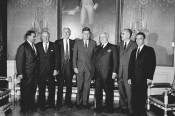Today’s Wonder of the Day was inspired by Mitch. Mitch Wonders, “What is Murphy's law ?” Thanks for WONDERing with us, Mitch!
Have you ever had one of those days? You wake up and fall out of bed when you get wrapped up in the covers. On your way to the shower, you trip over your skateboard and then stub your toe on the door jamb.
As soon as you get your hair lathered up with shampoo, all the hot water runs out. When you step out of the shower shivering, you realize you forgot to grab a towel. Can this morning get any worse? It seems like whatever can go wrong this morning has indeed gone wrong.
If you've ever had a day like this, then you're probably already familiar with Murphy's Law. Murphy's Law is an idiom that means if anything can go wrong, it will. Is there any truth to it, though? And exactly who is this Murphy anyway?
The idea at the heart of Murphy's Law — if anything can go wrong, it will — has been around for a long, long time. It reflects a basic pessimism about life that many people point to and find comfort in when things just aren't going their way.
The idea is often expanded upon. For example, you may hear people claim that if anything can go wrong, it will…and at the worst possible time and in the worst possible way. You might also hear it restated in a myriad of different ways, such as if you drop a piece of toast, it's sure to land buttered-side down.
Variations of Murphy's Law have been around for many years and go by many different names, including Sod's Law, Finagle's Law, the Fourth Law of Thermodynamics, Newton's Fourth Law of Motion, and the Inverse Midas Touch. Most of these were in use long before the term Murphy's Law became popular.
So who was this Murphy? Some people believe there never was a real Murphy. Instead, they claim Murphy was a name given to a bumbling mechanic that appeared in old Navy cartoons around the time of World War II. Others, though, believe that there was indeed a Murphy.
In fact, Murphy's Law is usually credited to Captain Edward A. Murphy, Jr. Captain Murphy was an Air Force engineer who participated in deceleration testing in 1949 at Edwards Air Force Base in California.
During the testing, Captain Murphy discovered that all 16 deceleration sensors had been installed incorrectly. Each sensor could be installed in two ways, and in each and every case the sensor had been installed incorrectly.
Basically, if anything could go wrong, it did. Murphy said something to that effect, others repeated it, and the idea has been more commonly known as Murphy's Law ever since.
Murphy's Law remains a popular concept, because we tend to focus on negative events and look for reasons when things go badly. Put another way, we tend to ignore all the things that go right throughout the day. When things go wrong, however, we tend to wring our hands and cry out, "Why?"
While it may be popular to blame bad things on Murphy's Law, is there any scientific support for it? Maybe! Some scientists believe the second law of thermodynamics, also known as the law of entropy, supports Murphy's Law.
According to the law of entropy, in our universe, systems naturally tend to end up in disorder. While that may apply on a grand scale over time, it probably doesn't explain why you tripped over your skateboard or ran out of hot water in the shower!


.jpg)









Rylee
mari doyle watermelon
martinmadness124
Jacob
Niko